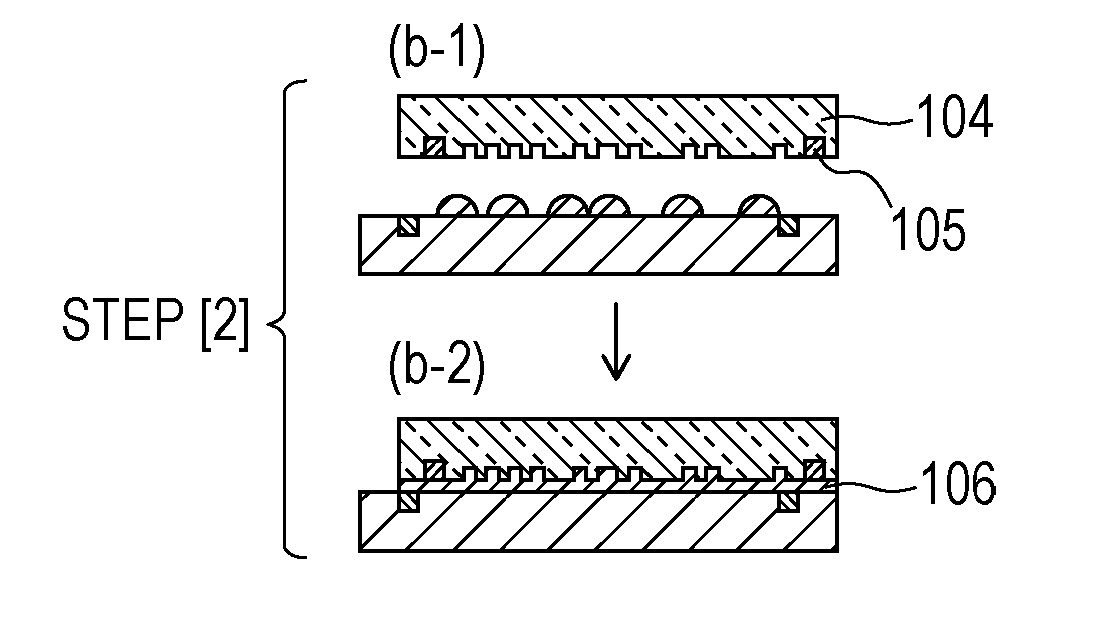Photocurable composition, and methods using the same for forming cured product pattern and for manufacturing optical component, circuit board and imprinting mold
- Summary
- Abstract
- Description
- Claims
- Application Information
AI Technical Summary
Benefits of technology
Problems solved by technology
Method used
Image
Examples
example 1
[0219](1) Preparation of Photocurable Composition (a-1)
[0220]The following Component (A) and Component (E) (Component (B)) were mixed, and the mixture was filtered through a 0.2 μm ultrahigh molecular weight polyethylene filter to yield photocurable composition (a-1) of Example 1.
[0221](1-1) Component (A): 94 Parts by Weight in Total
[0222] Isobornyl acrylate IB-XA (product name, produced by Kyoeisha Chemical): 9.0 parts by weight
[0223] Benzyl acrylate V #160 (product name, produced by Osaka Organic Chemical Industry): 38 parts by weight
[0224] Neopentyl glycol diacrylate NP-A (product name, produced by Kyoeisha Chemical): 47 parts by weight
[0225](1-2) Component (B): 13 Parts by Weight in Total
[0226] Lucirin TPO (produced by BASF): 3 parts by weight
[0227] Benzophenone (produced by Tokyo Chemical Industry): 10 parts by weight
[0228]In photocurable composition (a-1), Component (A) had an Ohnishi parameter OA of 3.53, and Component (E) had an Ohnishi parameter OE of 2.04. In photocurable ...
example 2
[0234](1) Preparation of Photocurable Composition (a-2)
[0235]The following Component (A) and Component (E) (or (B)) were mixed, and the mixture was filtered through a 0.2 μm ultrahigh molecular weight polyethylene filter to yield photocurable composition (a-2) of Example 2.
[0236](1-1) Component (A): 94 Parts by Weight in Total
[0237] Isobornyl acrylate IB-XA (product name, produced by Kyoeisha Chemical): 9.0 parts by weight
[0238] Benzyl acrylate V #160 (product name, produced by Osaka Organic Chemical Industry): 38 parts by weight
[0239] Neopentyl glycol diacrylate NP-A (product name, produced by Kyoeisha Chemical): 47 parts by weight
[0240](1-2) Component (B): 18 Parts by Weight in Total
[0241] Lucirin TPO (produced by BASF): 3 parts by weight
[0242] Benzophenone (produced by Tokyo Chemical Industry): 15 parts by weight
[0243]Photocurable composition (a-2) had an OA value of 3.53 and an OE value of 2.03. In photocurable composition (a-2), the content of Component (E) or (B) was 16.1% by ...
example 3
[0250](1) Preparation of Photocurable Composition (a-3)
[0251]The following Component (A) and Component (E) (Component (B)) were mixed, and the mixture was filtered through a 0.2 μm ultrahigh molecular weight polyethylene filter to yield photocurable composition (a-3) of Example 3.
[0252](1-1) Component (A): 94 Parts by Weight in Total
[0253] Isobornyl acrylate IB-XA (product name, produced by Kyoeisha Chemical): 9.0 parts by weight
[0254] Benzyl acrylate V #160 (product name, produced by Osaka Organic Chemical Industry): 38 parts by weight
[0255] Neopentyl glycol diacrylate NP-A (product name, produced by Kyoeisha Chemical): 47 parts by weight
[0256](1-2) Component (B): 23 Parts by Weight in Total
[0257] Lucirin TPO (produced by BASF): 3 parts by weight
[0258] Benzophenone (produced by Tokyo Chemical Industry): 20 parts by weight
[0259]In photocurable composition (a-3), Component (A) had an Ohnishi parameter OA of 3.53, and Component (E) had an Ohnishi parameter OE of 2.02. In photocurable ...
PUM
| Property | Measurement | Unit |
|---|---|---|
| Fraction | aaaaa | aaaaa |
| Fraction | aaaaa | aaaaa |
| Percent by mass | aaaaa | aaaaa |
Abstract
Description
Claims
Application Information
 Login to view more
Login to view more - R&D Engineer
- R&D Manager
- IP Professional
- Industry Leading Data Capabilities
- Powerful AI technology
- Patent DNA Extraction
Browse by: Latest US Patents, China's latest patents, Technical Efficacy Thesaurus, Application Domain, Technology Topic.
© 2024 PatSnap. All rights reserved.Legal|Privacy policy|Modern Slavery Act Transparency Statement|Sitemap


